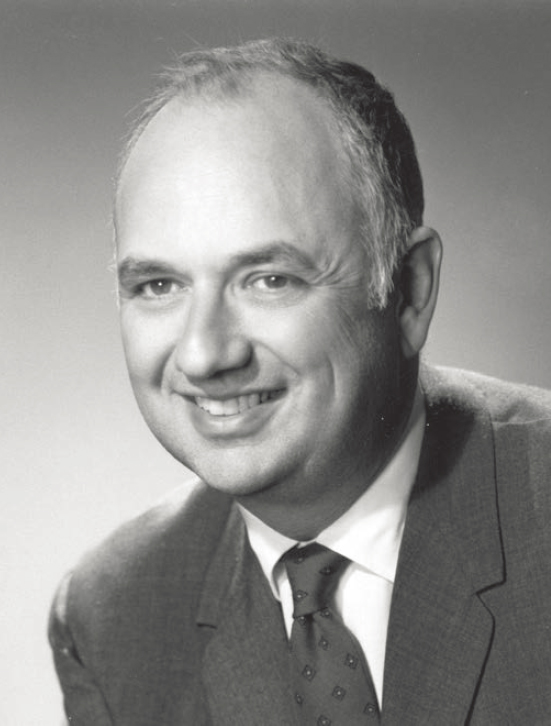
ROBERT R. EVERETT
1921–2018
Elected in 1979
“Pioneering of digital computer and their application to real time control systems.”
ROBERT RIVERS EVERETT, recognized as a leader in the development of the systems engineering discipline and former president and CEO of the MITRE Corporation, died August 15, 2018, at the age of 97.
Bob was born June 26, 1921, in Yonkers, New York. His father was a civil engineer who designed waterworks; as the young Bob accompanied him on trips to visit various projects such as power plants and pumping stations, he grew up expecting to be an engineer. He earned his bacherlor’s degree from Duke University in 1942 and in 1943 his master of science degree from the Massachusetts Institute of Technology (MIT), both in electrical engineering.
As a graduate student he worked in the MIT Servomechanisms Lab with Jay Forrester, who he said “had an enormous effect” on him. They remained lifelong friends.
He then went to work at MIT’s Lincoln Laboratory (1944–58), serving in a leadership role on the Whirlwind digital computer project that inspired the design of the Air Force’s first digital computer-based air defense system, the semiautomatic ground environment (SAGE). To focus on system integration issues associated with the application of Whirlwind technology to the SAGE project, leaders from the Air Force and MIT decided to create a nonprofit public interest company, the MITRE
Corporation. Within a short period of time after its creation, 485 members of the Lincoln Laboratory staff transferred to the newly formed company, with Bob accepting a position as its technical director. In 1969 he was selected to serve as president and CEO of MITRE and continued in that role until his retirement in 1986.
In that position he developed a corporate mission for MITRE of “system engineering in the public interest,” which he defined to consist of two major areas of activity. The first, based on his experience with the Whirlwind project, was to enable significant enhancement of government capabilities by identifying innovations in electronics and computing that could be the basis for new government systems to both enhance capabilities and lower costs. The second, based on his early experiences with implementation of the SAGE system, involved addressing system integration issues associated with the adoption of new electronics technology. He directed MITRE toward supporting high-priority, high-tech government innovation projects by systematically identifying and managing technology-related risks at the start of a new system development project and responding to unidentified situations that emerge as system implementation progresses.
Bob also recognized that MITRE needed an education program to expose its employees to actual company experiences related to technology innovation opportunities, identifying associated risks and risk management responses. He formed the MITRE Institute for the company’s engineering workforce to learn about high-value cases from MITRE project leaders supporting government system development projects. The institute helped to foster a company culture that placed extraordinary value on “systems engineering in the public interest,” thereby attracting highly talented engineers to join the company with expectations of positively influencing successful development of government systems that would benefit from electronics technology innovations.
Under Bob’s leadership, MITRE supported major government system development programs in a significant number of application domains—from defense and homeland security
to air traffic control and health care—building on technological innovations in computing, communications networks, sensors, system control, human-machine interfaces, and cybersecurity, among others.
Bob’s technology and leadership contributions were well recognized, including through his election to the NAE and selection to receive the the highest civilian recognition award from the Department of Defense, the Public Service Medal (1983), and the National Medal of Technology (1989, shared with Jay Forrester), presented by President George H.W. Bush. He also received the Eugene Fubini Award from the Defense Science Board and was recognized as a fellow of IEEE and the Computer History Museum (“For his work on the MIT Whirlwind and SAGE computer system and B17:B41—a lifetime of directing advanced research and development projects”). He received honorary degrees from Duke University and Northeastern University, chaired the Defense Science Board, and was honored with the dedication of MITRE’s new laboratory building to Robert R. Everett.
But perhaps his most satisfying form of recognition was to be elected to a lifetime role on the MITRE board of trustees, permitting him to observe and influence the company’s continuously growing contributions to system engineering in the public interest.
One of Bob’s greatest strengths was his deep concern for all the people in his life. While pioneering valuable new engineering technologies and molding the MITRE Corporation into a world-renowned center of excellence, he remained a great friend, a loving husband, and a devoted and attentive father to his six sons.
He is survived by his wife, Ann T. Everett; sons Robert, Bruce, Ted, Doug, Michael, and David; six grandchildren; and four great-grandchildren.




